NASA's Phoenix lander got extra playtime in the Martian dirt on Tuesday, doing another practice dig as scientists tried to perfect the technique ahead of the actual excavation.
"The team felt they weren't really comfortable yet with the digging and dumping process," said chief scientist Peter Smith of the University of Arizona, Tucson. "They haven't really mastered it."
The extra practice means the earliest that Phoenix would flex its 8-foot robotic arm to claw below the arctic plains for scientific study would be Wednesday.
Smith compared Phoenix's antics to a child playing on the beach with a sand pail and shovel.
"But we're doing it blind from 170 million miles away," he said.
Phoenix landed near the Martian north pole on May 25 on a three-month mission to study whether the environment could be habitable for primitive life forms. Photographs revealed its three legs touched down on what appeared to be splotches of ice that were uncovered when its firing thrusters blew away loose soil.
Phoenix got its first touch of Mars on Sunday when it scooped up and then dumped a handful of soil in a region that scientists dubbed the "Knave of Hearts." The scoop contained intriguing white specks that scientists think could be surface ice or salt.
For the second practice "dig and dump," engineers told the robot to go slightly deeper in the same region and use the camera on its arm to take photos this time.
When Phoenix starts its scientific work, it will deliver scoopfuls of dirt to several onboard instruments including a tiny oven. The oven will bake the sample and analyze the vapors for traces of organic compounds that are the chemical building blocks of life.
New photos sent back by Phoenix showed one of the spring-loaded doors on the oven failed to open all the way. Scientists hope the midday temperatures will make the door less sticky, but it can still be used with a partially open oven door, Smith said.
The $420 million mission is led by the University of Arizona and managed by NASA's Jet Propulsion Laboratory in Pasadena.
